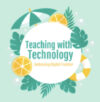Reflecting on Learning and Growth
Photo by Thought Catalog on Unsplash
In the weekly sessions, we delved into the shift to online education, underscoring the need to maintain a human-centric approach. We analyzed scholarly articles around technology-based teaching philosophies, covered WordPress, and tactics for crafting engaging, multimedia-rich learning experiences. However, we also emphasized that technology can’t stand in for the essential human connection in education. We need to focus on relationships between teachers and students rather than relying solely on technological solutions and call for a more thoughtful and inclusive approach to digital learning.
Besides our weekly meetings, this course encouraged self-directed learning, critical thinking, and writing skills as well. The instructors were super handy, knowledgeable, and helped address individual needs, preparing us to integrate the right type and amount of technology into our teaching methods. The in-class activities were very useful in shaping our thoughts, exchanging ideas and experiences of individual teaching pedagogies.
One super-useful session was when we figured out how to create impactful PowerPoint slides (design strategies for PowerPoints). We picked up the importance of nailing colors, fonts, alignment, and making sure our content makes sense and looks cohesive. We learned how to use shapes and bullet points for a smooth flow of ideas. Since that session, I have modified information on my slides to suit the learning concepts and differentiate instructions to match the learning capabilities of my students.
This course seems most effective for teachers who run classes more independently over the internet, whether synchronous or asynchronous interactions. In light of these multiple possibilities, and before choosing a teaching tool, we should consider how technology promotes deep, integrative, and critical learning. We can’t simply assume students are familiar with using institutionally supported channels of communication (e.g. Brightspace); we need to provide training and clarify tool usage.
My favorite part of this course has been discovering how to make hyperdocs for self-paced learning. It’s personalized, engaging, and authentic, making teaching more efficient. It’s fantastic that students are motivated to participate independently. I’m excited to learn more about creating a technology-integrated curriculum.
My expectation from this course is that it will serve as a gateway to professional development and career growth. The course so far offered me fresh and engaging approaches to teaching styles, keeping student engagement at the centre of everything that we do. This course has been a breath of fresh air, showing that online teaching can be engaging and effective when we tailor it to students’ needs, leverage technology, and foster active participation and feedback. It demonstrates that a dynamic online class can still meet learning goals and promote meaningful discussions. We checked out a bunch of teaching tools and apps for all age groups. I also found this cool eLearning program, BigBlueButton, which is pretty fun and dynamic. By the end of this course, I want to feel confident teaching with tech, creating engaging lessons, and staying organized with these educational tools.

